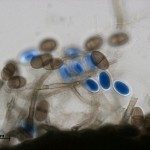Lien vers Pubmed [PMID] – 19759217
J. Clin. Microbiol. 2009 Dec;47(12):3862-70
Thirty-eight isolates (including 28 isolates from patients) morphologically identified as Lichtheimia corymbifera (formerly Absidia corymbifera) were studied by sequence analysis (analysis of the internal transcribed spacer [ITS] region of the ribosomal DNA, the D1-D2 region of 28S, and a portion of the elongation factor 1alpha [EF-1alpha] gene). Phenotypic characteristics, including morphology, antifungal susceptibility, and carbohydrate assimilation, were also determined. Analysis of the three loci uncovered two well-delimited clades. The maximum sequence similarity values between isolates from both clades were 66, 95, and 93% for the ITS, 28S, and EF-1alpha loci, respectively, with differences in the lengths of the ITS sequences being detected (763 to 770 bp for isolates of clade 1 versus 841 to 865 bp for isolates of clade 2). Morphologically, the shapes and the sizes of the sporangiospores were significantly different among the isolates from both clades. On the basis of the molecular and morphological data, we considered isolates of clade 2 to belong to a different species named Lichtheimia ramosa because reference strains CBS 269.65 and CBS 270.65 (which initially belonged to Absidia ramosa) clustered within this clade. As neotype A. corymbifera strain CBS 429.75 belongs to clade 1, the name L. corymbifera was conserved for clade 1 isolates. Of note, the amphotericin B MICs were significantly lower for L. ramosa than for L. corymbifera (P < 0.005) but were always <or=0.5 microg/ml for both species. Among the isolates tested, the assimilation of melezitose was positive for 67% of the L. ramosa isolates and negative for all L. corymbifera isolates. In conclusion, this study reveals that two Lichtheimia species are commonly associated with mucormycosis in humans.




